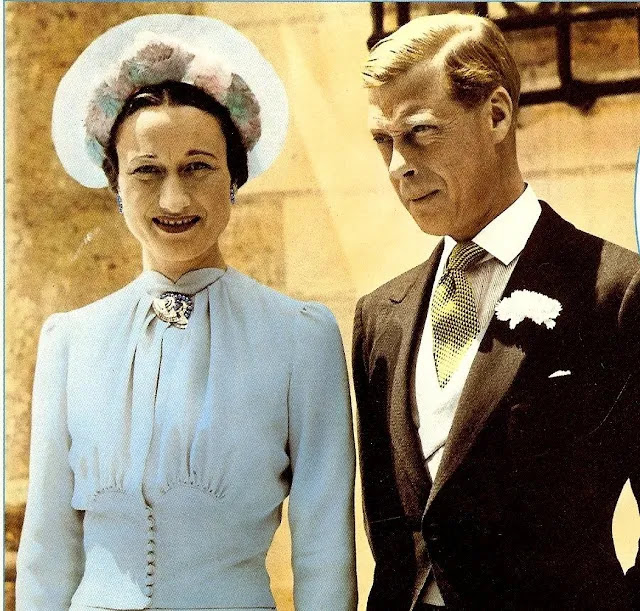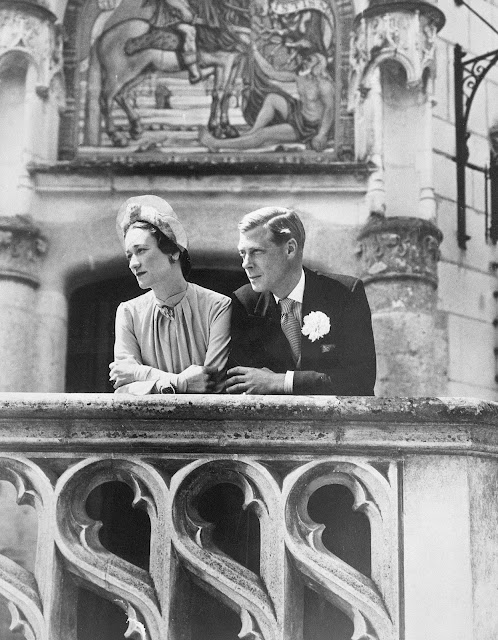 |
| The Duke and Duchess of Windor. Image from Rebecca Star Brown |
The wedding of Edward, Duke of Windsor, and Wallis Simpson on June 3, 1937, was a notable and controversial event. The ceremony took place at the Château de Candé in Monts, France, a small and private affair devoid of the royal family's presence. This resulted from Edward's abdication from the British throne six months earlier, which had caused a constitutional crisis. Edward abdicated because he could not continue as king without the woman he loved, Wallis Simpson, the two-time American divorcee.
Wallis Simpson wore a dress in a custom shade of blue, later known as "Wallis blue," designed by Mainbocher. This gown, made of silk crepe, featured a nipped waist, a fitted skirt, and a high-neck jacket with long sleeves. She accessorized with a hat by Caroline Reboux and a significant sapphire and diamond brooch.
The ceremony was intimate, with only a few close friends in attendance, including Randolph Churchill and Major Edward "Fruity" Metcalfe. Dr. Mercier, the Mayor of Monts, performed the simple civil ceremony according to the laws of the French Republic. This was followed by a Church of England ceremony conducted by Rev. R. Anderson Jardine, vicar of St. Paul’s, Darlington, who stepped in after the Church of England refused to sanction the marriage. Mr. Hermann Rogers gave the bride away, and Major E. D. Metcalfe served as the best man.
Following the ceremonies, the Duke and Duchess of Windsor issued two personal messages. The first read:
"The Duchess and I wish to thank all those who have kindly sent us presents and good wishes on the occasion of our marriage. We shall never forget their friendly messages, which mean so much to us this day. After the trying times we have been through, we now look forward to a happy and useful private life, and to that measure of peace that we hope will be granted us."
In the second message, addressed to the world’s press, the Duke and Duchess expressed gratitude to journalists for the courtesy shown during the unprecedented circumstances. They acknowledged the unavoidable inaccuracies in reports during these challenging months but noted the efforts to correct them. Understanding the difficulties, they appealed to the global press for consideration and privacy, which they felt was now deserved.
The Times' special correspondent documented the ceremony:
The drawing-room of the Chateau de Cande, in which the civil marriage was celebrated, is an oak-panelled room on the ground floor with French windows opening on to the terrace. A long oak table, on which were a large bowl of peonies, a copy of the French Civil Code, and the register of the commune of Monts, had been paced across one end of the room. In front of the table stood four armchairs for the Duke, Mrs. Warfield, and the two witnesses (Major Metcalfe and Mr. Hermann Rogers). Behind them were other chairs for Mrs. Merriman (Mrs. Warfield’s aunt), the chateau staff, and the five news agency representatives.
When the Mayor was ready at the table the Duke and Mrs. Warfield, attended by their witnesses, entered the drawing-room. The company took their seats and remained seated while the Mayor read aloud the three relevant articles of the Civil Code, defined the mutual obligations of husband and wife in the 70 well-chosen words of the law, and asked the bride and groom whether they accepted one another as wife and husband. To these questions the Duke and Mrs. Warfield replies with the word “Oui.”
“In the name of the law,” said Dr. Mercier, “we declare that his Royal Highness, the Duke of Windsor, and Mrs. Wallis Warfield are united by marriage.” A speech from the Mayor concluded the civil ceremony.
The Company now moved to the music room, also on the ground floor, where the religious service was to be celebrated. An altar surmounted by a gilded cross stood at one end of the room. Before it the Rev. Anderson Jardine conducted the service. There was no choral singing, but music was played on the private organ of the chateau. The hymn “O Perfect Love” was played during the Benediction.
The Duke and Duchess received the congratulations of the guests in the drawing-room after the service. Two bouquets were then presented to the Duchess, one of pink roses from M. Blum, the French Prime Minister, and the other from the Prefect of the Indre and Loire Department and Mme. Vernet.
There was afterwards a buffet luncheon, and it ended with the cutting of a large wedding cake, which was about 3ft. high, by the Duke and Duchess together. At the same time the morning’s batch of congratulatory telegrams—about 2000—was brought in. Major Metcalfe proposed the health of the Duke and Duchess and the Duke replied.
The Duke and Duchess left the chateau by motor-car in the evening. They were to catch the Arlberg express at Laroche Migennes, and they will spend their honeymoon at the Castle of Wasserleonburg in Carinthia.
Despite the absence of the royal family, the event attracted substantial media attention, and every detail was extensively covered in the press. The couple's official wedding portraits were taken by renowned photographer Cecil Beaton. Following their wedding and their honeymoon, they settled into a life of retirement, largely spent in France, but punctuated by a stint as governor general of the Bahamas from 1940 until 1945. Their marriage, though it cost Edward his crown, remained a significant part of royal history, emblematic of love and personal sacrifice over royal duty.


.png)





0 Comments